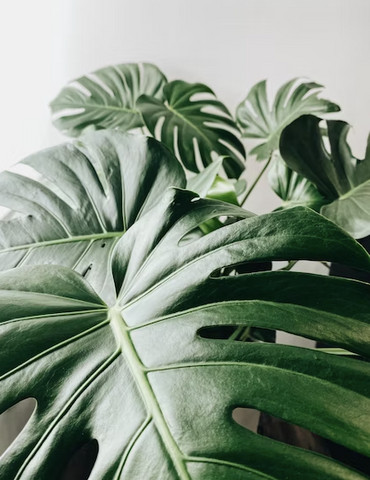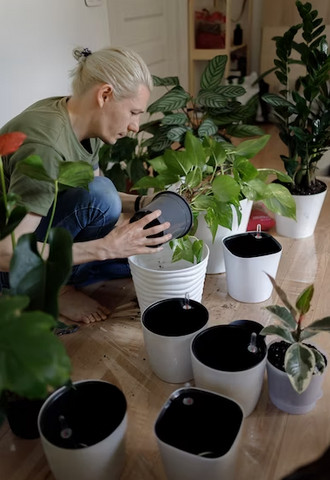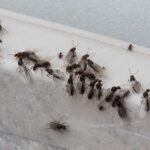Dealing with a fruit fly infestation in your houseplants can be frustrating, but it’s definitely manageable; find out how at flyermedia.net. Getting rid of these pests involves a combination of methods that target both the adult flies and their larvae. You’ll learn how to eliminate fungus gnats and prevent them from returning to your plants. Plus, discover essential tips for maintaining healthy plant care practices.
1. What Exactly Are Fruit Flies in Houseplant Soil?
Fruit flies in houseplant soil, often called fungus gnats, are small, dark, short flies that thrive in moist soil rich in organic matter. They are typically of the Bradysia species.
Identifying Fungus Gnats: Fungus gnats are frequently mistaken for fruit flies, but some key differences can help you distinguish them:
- Size and Appearance: Fungus gnats are smaller than typical fruit flies, measuring about 1/8 inch in length. They have slender bodies and long legs. Their wings are usually gray or clear.
- Behavior: Adult fungus gnats are weak fliers and are often seen crawling on the soil surface or flying short distances when disturbed.
- Habitat: Unlike fruit flies that are attracted to overripe fruit, fungus gnats are drawn to moist soil, fungi, and decaying organic matter.
 Fungus gnats on soil
Fungus gnats on soil
Life Cycle: Understanding the life cycle of fungus gnats is crucial for effective control:
- Egg Stage: Adult female gnats lay eggs (up to 200) in the top layer of moist soil.
- Larval Stage: Once hatched, the larvae feed on fungi, decaying organic matter, and sometimes the roots of plants. This stage can last for about 2-3 weeks.
- Pupal Stage: The larvae then pupate in the soil for about 3-7 days.
- Adult Stage: Adult gnats emerge from the pupae, ready to mate and lay more eggs, continuing the cycle. Adults live for about 7-10 days.
2. What Causes Fruit Flies (Fungus Gnats) in Your Houseplants?
Fungus gnats are attracted to moist conditions and decaying organic matter, which are commonly found in houseplant soil. There are several factors that can contribute to a fungus gnat infestation.
2.1. Overwatering
One of the primary causes of fungus gnats is overwatering. Moist soil creates an ideal breeding ground for these pests, allowing them to lay eggs and thrive. Ensuring your plants have proper drainage can help prevent this issue.
2.2. Poor Soil Drainage
Heavy, dense potting soil that retains too much moisture can also contribute to fungus gnat problems. Improving soil drainage by using well-draining soil mixes can reduce the likelihood of an infestation.
2.3. Contaminated Potting Soil
New potting soil can sometimes be contaminated with fungus gnat eggs or larvae. Always inspect new soil before using it, or consider sterilizing it to kill any potential pests.
2.4. Decaying Organic Matter
The presence of decaying leaves, roots, or other organic matter in the soil provides a food source for fungus gnat larvae. Regularly removing dead plant material can help prevent infestations.
2.5. Introduction from Outdoors
Fungus gnats can enter your home through open windows or doors, especially if you bring plants indoors after they’ve been outside. Inspecting plants before bringing them inside can help prevent this.
3. What Are the Signs of a Fruit Fly (Fungus Gnat) Infestation?
Recognizing the signs of a fungus gnat infestation early can help you take action before the problem becomes severe.
3.1. Adult Flies
The most obvious sign is the presence of small, dark flies buzzing around your houseplants. These flies are often seen near the soil surface or flying short distances when disturbed.
3.2. Larvae in the Soil
You may be able to spot the larvae by carefully examining the top layer of soil. They appear as tiny, white or translucent worms with black heads.
3.3. Plant Damage
In severe infestations, fungus gnat larvae can feed on plant roots, leading to stunted growth, yellowing leaves, and overall decline in plant health.
3.4. Sticky Traps
Using yellow sticky traps can help you monitor and confirm a fungus gnat infestation. If you find small, dark flies stuck to the traps, it’s a clear indication of a problem.
4. What Are Natural Methods to Eliminate Fruit Flies (Fungus Gnats)?
Getting rid of fungus gnats naturally involves using non-toxic methods that target both the adult flies and their larvae. Here are some effective strategies:
4.1. Letting the Soil Dry
Allowing the top layer of soil to dry out completely between waterings can help kill fungus gnat larvae and prevent them from thriving. Fungus gnats need moisture to survive, so depriving them of it can be very effective.
4.2. Repotting Your Plant
Repotting your plant with fresh, well-draining soil can help eliminate fungus gnat larvae and eggs. Be sure to remove as much of the old soil as possible from the roots before repotting. Plants found in big box stores are often potted in heavily dense potting soil, the perfect breeding ground for fungus gnat larvae. Using a well draining chunky soil mix can do wonders for your plants.
 Repotting plants
Repotting plants
4.3. Using Hydrogen Peroxide
A solution of equal parts water and 3% hydrogen peroxide can be used to water your plants. Hydrogen peroxide kills fungus gnat larvae on contact without harming your plants. This solution also helps combat root rot. After treating with hydrogen peroxide, remember to follow up with fertilizer since it can target good bacteria as well.
4.4. Creating a DIY Gnat Trap with Vinegar
A simple gnat trap can be made by mixing equal parts apple cider vinegar and water in a bowl. Add a drop of dish soap to break the surface tension. The sweet scent of the vinegar attracts adult gnats, causing them to drown in the solution.
4.5. Employing Yellow Sticky Stakes
Yellow sticky traps are great for capturing adult fungus gnats. Place the traps near the soil surface of your houseplants. The bright yellow color attracts the flies, trapping them on the sticky surface.
4.6. Bottom Watering Your Plants
Watering your plants from the bottom can help keep the top layer of soil dry, making it less attractive to fungus gnats. Place your plant in a tub of water and allow it to absorb moisture through the drainage holes.
4.7. Introducing Beneficial Insects
Beneficial nematodes are microscopic organisms that feed on fungus gnat larvae in the soil. Introducing nematodes to your plants can help control infestations naturally. Nematodes need to be watered in, so be sure to follow package instructions.
4.8. Utilizing Mosquito Bits
Mosquito Bits contain Bacillus thuringiensis israelensis (BTI), a biological larvicide that is effective against fungus gnat larvae. Soak the Mosquito Bits in water and use the water to irrigate your plants, or sprinkle the granules on the soil surface.
5. What Chemical Treatments Can Be Used to Eliminate Fruit Flies?
If natural methods are not enough, chemical treatments can be used to eliminate fruit flies. However, it’s important to use these products carefully and follow the instructions on the label.
5.1. Insecticidal Soap
Insecticidal soap can be sprayed on the soil surface and foliage to kill adult fungus gnats. Be sure to apply the soap thoroughly, covering all affected areas.
5.2. Pyrethrin Sprays
Pyrethrin-based insecticides are effective against adult fungus gnats. These sprays are derived from chrysanthemum flowers and are considered relatively safe for use around plants.
5.3. Systemic Insecticides
Systemic insecticides are absorbed by the plant and can kill fungus gnat larvae that feed on the roots. These products should be used as a last resort, as they can have negative impacts on the environment.
6. How Can You Prevent Future Fruit Fly Infestations?
Preventing future fungus gnat infestations involves maintaining good plant care practices and taking steps to avoid creating favorable conditions for these pests.
6.1. Watering Plants Properly
Avoid overwatering your plants and allow the top layer of soil to dry out between waterings. Use a moisture meter to monitor soil moisture levels and water only when necessary.
6.2. Using Well-Draining Soil
Plant your houseplants in well-draining soil mixes that do not retain too much moisture. Add perlite, vermiculite, or coarse sand to improve drainage.
6.3. Inspecting New Plants
Before bringing new plants into your home, carefully inspect them for signs of fungus gnats or other pests. Quarantine new plants for a few weeks to ensure they are pest-free.
6.4. Removing Decaying Matter
Regularly remove dead leaves, flowers, and other organic matter from the soil surface to eliminate potential food sources for fungus gnat larvae.
6.5. Maintaining Good Air Circulation
Ensure your plants have good air circulation to help the soil dry out more quickly. Use fans to improve airflow in humid environments.
 Plants on shelf
Plants on shelf
6.6. Sterilizing Potting Soil
If you are concerned about contaminated potting soil, you can sterilize it by baking it in the oven at 180°F (82°C) for 30 minutes. This will kill any fungus gnat eggs or larvae.
7. What Kind of Soil is Best to Prevent Fruit Flies?
Choosing the right type of soil is crucial for preventing fungus gnats. Well-draining soil that does not retain too much moisture is ideal.
7.1. Well-Draining Soil Mixes
Use potting mixes that contain ingredients like perlite, vermiculite, coarse sand, or bark. These materials improve drainage and aeration, creating an environment that is less favorable to fungus gnats.
7.2. Avoiding Heavy Soils
Avoid using heavy, clay-based soils that retain too much moisture. These soils create ideal conditions for fungus gnats to thrive.
7.3. Soil Amendments
Amend your potting soil with organic matter like compost or peat moss, but be careful not to overdo it. Too much organic matter can retain excess moisture and attract fungus gnats.
8. What Role Does Humidity Play in Fruit Fly Infestations?
Humidity can play a significant role in fungus gnat infestations. High humidity levels can create moist conditions that favor the development of these pests.
8.1. High Humidity and Fungus Gnats
High humidity levels can slow down the evaporation of moisture from the soil, creating an environment that is conducive to fungus gnat growth.
8.2. Controlling Humidity
Controlling humidity levels in your home can help prevent fungus gnat infestations. Use dehumidifiers to reduce humidity, especially in areas where you keep houseplants.
8.3. Improving Air Circulation
Good air circulation can help the soil dry out more quickly, even in humid conditions. Use fans to improve airflow around your plants.
9. Are Some Plants More Susceptible to Fruit Flies Than Others?
Some plants are more prone to fungus gnat infestations than others, depending on their watering needs and the type of soil they prefer.
9.1. Plants That Prefer Moist Soil
Plants that require consistently moist soil, such as ferns and African violets, are more likely to attract fungus gnats. Monitor these plants carefully and avoid overwatering.
9.2. Plants in Poorly Draining Soil
Plants that are planted in poorly draining soil are also more susceptible to fungus gnat infestations. Repot these plants in well-draining soil mixes.
9.3. Plants with Decaying Matter
Plants that accumulate dead leaves or other organic matter on the soil surface are more likely to attract fungus gnats. Regularly remove any decaying matter from these plants.
10. How Can flyermedia.net Help With Your Houseplant Problems?
At flyermedia.net, we understand the challenges of maintaining healthy houseplants, especially when dealing with pests like fungus gnats. We offer a variety of resources to help you overcome these issues and keep your plants thriving.
10.1. Expert Advice
Our website features articles and guides written by experienced horticulturalists who provide practical advice on plant care, pest control, and soil management.
10.2. Product Recommendations
We recommend a range of products that can help you prevent and control fungus gnat infestations, including well-draining soil mixes, beneficial nematodes, and yellow sticky traps.
10.3. Community Support
Join our online community to connect with other plant enthusiasts, share your experiences, and get advice from fellow gardeners.
10.4. Educational Resources
Access our extensive library of articles, videos, and tutorials on all aspects of houseplant care, from watering and fertilizing to pest and disease management.
10.5. Local Resources
Find local nurseries, garden centers, and horticultural services in your area through our comprehensive directory.
Dealing with fruit flies (fungus gnats) in houseplant soil can be a challenge, but with the right strategies and information, you can effectively eliminate these pests and prevent future infestations. Remember to focus on proper watering practices, well-draining soil, and regular monitoring of your plants. Visit flyermedia.net for more information and resources to help you maintain healthy and thriving houseplants.
Address: 600 S Clyde Morris Blvd, Daytona Beach, FL 32114, United States
Phone: +1 (386) 226-6000
Website: flyermedia.net
FAQ About Getting Rid of Fruit Flies in Houseplant Soil
1. Are fruit flies in houseplant soil harmful to my plants?
Fruit flies, or fungus gnats, are mostly a nuisance. However, in large numbers, their larvae can damage plant roots, leading to stunted growth and yellowing leaves.
2. How do I know if I have fungus gnats and not fruit flies?
Fungus gnats are smaller and darker than fruit flies. They are also more commonly found near the soil of houseplants, while fruit flies are attracted to overripe fruit and other sugary substances.
3. Can I use regular fly spray to get rid of fungus gnats?
While fly spray can kill adult fungus gnats, it is not a long-term solution and can be harmful to your plants and your health. It is better to use natural or targeted chemical treatments.
4. How often should I water my plants to prevent fungus gnats?
Water your plants only when the top inch of soil feels dry to the touch. Overwatering creates moist conditions that favor fungus gnat growth.
5. What is the best soil mix to prevent fungus gnats?
Use a well-draining soil mix that contains perlite, vermiculite, or coarse sand. These materials improve drainage and aeration, making the soil less attractive to fungus gnats.
6. Are yellow sticky traps effective against fungus gnats?
Yes, yellow sticky traps are effective for capturing adult fungus gnats. Place the traps near the soil surface to monitor and control the population.
7. Can I use hydrogen peroxide to treat a fungus gnat infestation?
Yes, a solution of equal parts water and 3% hydrogen peroxide can be used to water your plants. This kills fungus gnat larvae on contact without harming your plants.
8. Do beneficial nematodes really work against fungus gnats?
Yes, beneficial nematodes are a natural and effective way to control fungus gnat larvae in the soil. They feed on the larvae, helping to reduce the population.
9. How can I sterilize potting soil to prevent fungus gnats?
You can sterilize potting soil by baking it in the oven at 180°F (82°C) for 30 minutes. This will kill any fungus gnat eggs or larvae.
10. Where can I find more information about controlling fungus gnats?
Visit flyermedia.net for more articles, guides, and resources on houseplant care and pest control. Our experts are here to help you keep your plants healthy and thriving.
